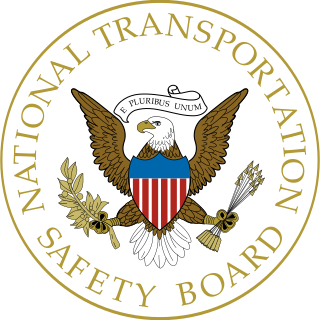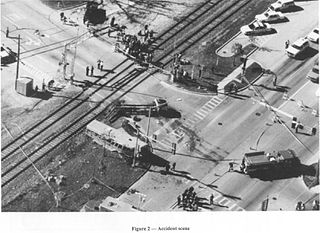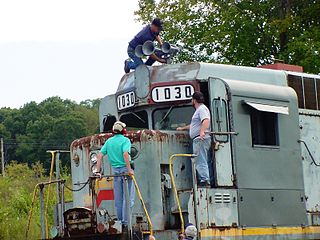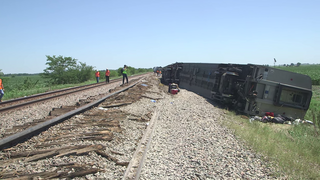
Operation Lifesaver is the largest rail safety organization in the United States. [1] It was founded by the Union Pacific Railroad in the early 1970s. [2]

Operation Lifesaver is the largest rail safety organization in the United States. [1] It was founded by the Union Pacific Railroad in the early 1970s. [2]
In 1972, the Idaho State Highway Patrol, then-Governor Cecil Andrus and the Union Pacific Railroad mounted campaign to promote "Stop, Look and Listen" safety at highway-rail grade crossings. The initial teams spoke to civic groups, school groups, school bus and truck drivers. Idaho experienced a 43% reduction in fatalities that first year. [3]
Operation Lifesaver has trained instructors and authorized volunteer speakers who provide free rail safety education programs across the U.S. and abroad. They give free presentations to school groups, driver education classes, community members, professional drivers, law enforcement officers, and emergency responders. Their programs are co-sponsored by federal, state and local government agencies, highway safety organizations and America's railroad systems. [4]
In 2006, Operation Lifesaver requested that Disney edit a scene of the Pixar film Cars in which the character of Lightning McQueen races a train to a grade crossing while the crossing lights are flashing. Disney/Pixar removed the scene in question from theater showings, but the DVD release of the movie still included the scene.[ citation needed ] Disney/Pixar created a series of PSAs featuring Lightning McQueen to promote safe driving habits. [5]
On October 14, 2016, Operation Lifesaver requested via a Facebook post that Hollister Co. remove advertisements from their website showing teenagers walking on railroad tracks. Hollister removed the advertisements five days later on October 19.[ citation needed ]
In September 2017, Operation Lifesaver spearheaded the observance of Rail Safety Week across the U.S. to raise awareness of the need for caution near railroad tracks and property. [6]
In 2018, Operation Lifesaver Canada, which had been holding rail safety week observances for years, aligned its Rail Safety Week dates to coincide with the U.S. observance.
Operation Lifesaver has been criticized for its strong ties to the railroad industry and the group's skew toward the railroad industry. The industry has reduced its support of the group’s efforts by providing fewer workers to help spread the group’s safety message. The group has also been criticized for not doing enough to support pedestrian railroad safety in the United States. [7]

The National Transportation Safety Board (NTSB) is an independent U.S. government investigative agency responsible for civil transportation accident investigation. In this role, the NTSB investigates and reports on aviation accidents and incidents, certain types of highway crashes, ship and marine accidents, pipeline incidents, bridge failures, and railroad accidents. The NTSB is also in charge of investigating cases of hazardous materials releases that occur during transportation. The agency is based in Washington, D.C. It has four regional offices, located in Anchorage, Alaska; Denver, Colorado; Ashburn, Virginia; and Seattle, Washington. The agency also operates a national training center at its Ashburn facility.

The Union Pacific Railroad is a Class I freight-hauling railroad that operates 8,300 locomotives over 32,200 miles (51,800 km) routes in 23 U.S. states west of Chicago and New Orleans. Union Pacific is the second largest railroad in the United States after BNSF, with which it shares a duopoly on transcontinental freight rail lines in the Western, Midwestern and West South Central United States.

The Chicago, Milwaukee, St. Paul and Pacific Railroad (CMStP&P), better known as the Milwaukee Road, was a Class I railroad that operated in the Midwest and Northwest of the United States from 1847 until 1986.

The Association of American Railroads (AAR) is an industry trade group representing primarily the major freight railroads of North America. Amtrak and some regional commuter railroads are also members. Smaller freight railroads are typically represented by the American Short Line and Regional Railroad Association (ASLRRA), although some smaller railroads and railroad holding companies are also members of the AAR. The AAR also has two associate programs, and most associates are suppliers to the railroad industry.

Wigwag is a nickname for a type of railroad grade crossing signal once common in North America, referring to its pendulum-like motion that signaled the approach of a train. The device is generally credited to Albert Hunt, a mechanical engineer at Southern California's Pacific Electric (PE) interurban streetcar railroad, who invented it in 1909 for safer railroad grade crossings. The term should not be confused with its usage in Britain, where "wigwag" generally refers to alternate flashing lights, such as those found at modern level crossings.

The Metrolink Ventura County Line is a commuter rail line serving Ventura County and the San Fernando Valley in Los Angeles County and the City of Los Angeles, in the Southern California system. The line is the successor of the short lived CalTrain commuter rail line.

A siding, in rail terminology, is a low-speed track section distinct from a running line or through route such as a main line, branch line, or spur. It may connect to through track or to other sidings at either end. Sidings often have lighter rails, meant for lower speed or less heavy traffic, and few, if any, signals. Sidings connected at both ends to a running line are commonly known as loops; those not so connected may be referred to as single-ended or dead-end sidings, or stubs.

The 1995 Fox River Grove bus–train collision was a grade crossing collision that killed seven students riding aboard a school bus in Fox River Grove, Illinois, on the morning of October 25, 1995. The school bus, driven by a substitute driver, was stopped at a traffic light with the rearmost portion extending onto a portion of the railroad tracks when it was struck by a Metra Union Pacific Northwest Line train en route to Chicago.
The BG&CM Railroad or Bountiful Grain and Craig Mountain Railroad is a Class III shortline railroad located in North Central Idaho.

A train horn is an air horn used as an audible warning device on diesel and electric-powered trains. Its primary purpose is to alert persons and animals to an oncoming train, especially when approaching a level crossing. They are often extremely loud, allowing them to be heard from great distances. They are also used for acknowledging signals given by railroad employees, such as during switching operations. For steam locomotives, the equivalent device is a train whistle.
The American Railway Engineering and Maintenance-of-Way Association (AREMA) is a North American railway industry group. It publishes recommended practices for the design, construction and maintenance of railway infrastructure, which are used in the United States and Canada.

The Mississippi Department of Transportation (MDOT) is the organization in charge of developing and maintaining all state and federal roadways in the U.S. state of Mississippi. In addition to highways, the department also has a limited role in supporting Mississippi's public transportation system, ports and waterways system, aeronautics and railroads. MDOT is headquartered in downtown Jackson.
Lincoln Industries Corp., also known as Progress Rail Services Corporation - Signals Division, manufactures railroad signal products sold to customers throughout North America. Founded in 1985, Lincoln Industries has been part of Caterpillar Inc. as a subsidiary of Progress Rail Services Corporation since January 8, 1998 and is organized under Progress Rail's Engineering and Track Services (ETS) group. Lincoln Industries maintains a headquarters and manufacturing facility in Louisville, Kentucky, a manufacturing facility in Jacksonville, Florida and has access to Progress Rail facilities throughout North America for staging materials.

The Ottawa bus–train crash was a collision that occurred between an OC Transpo double-decker bus and a Via Rail train in the Ottawa suburb of Barrhaven on September 18, 2013, that killed six people.

Last Clear Chance is a 1959 American short film produced and directed by Robert Carlisle.

On the evening of February 3, 2015, a commuter train on Metro-North Railroad's Harlem Line struck a passenger car at a grade crossing near Valhalla, New York, United States, between the Valhalla and Mount Pleasant stations, killing six people and injuring 15 others, seven very seriously. The crash is the deadliest in Metro-North's history, and at the time the deadliest rail accident in the United States since the June 2009 Washington Metro train collision, which killed nine passengers and injured 80.

The 2015 Oxnard train derailment occurred on February 24, 2015, at 5:44 a.m. local time when a Metrolink passenger train collided with a truck that a driver had mistakenly turned from Rice Avenue onto the tracks and became stuck. After impact, the train derailed at Oxnard, California, United States. As a result of the crash, the train engineer died from his injuries a week later and 32 passengers and crew members were injured. The truck driver exited his vehicle and ran from the scene prior to the crash; he sustained minor injuries that were unrelated to the crash sequence.
Pedestrian railroad safety is concerned with the protection of life through regulation, management and technology development of all forms of rail transportation. In the United States there are some 180,000 miles of track. Pedestrian railroad accidents are the leading cause of death on railways. More than 7,200 pedestrians have been killed by trains in the United States since 1997.

On November 8, 2016, Illinois voters approved the Illinois Transportation Taxes and Fees Lockbox Amendment, a legislatively referred constitutional amendment that prohibits lawmakers from using transportation funds for anything other than their stated purpose.

On June 27, 2022, the Southwest Chief, a passenger train operated by Amtrak, derailed near the small town of Mendon, Missouri. The derailment was caused by the train striking a dump truck that was obstructing the crossing of County Road 113, about three miles (4.8 km) southwest of Mendon. Four people were killed in the wreck: three passengers on board the train and the truck driver, with up to 150 people injured.
Operation Lifesaver is the nation's largest and most influential rail-safety group, but documents show that the organization is tightly bound to the railroad industry, and its critics, including many accident victims, say it inoculates railroads against liability in grade-crossing collisions
Operation Lifesaver, a nonprofit association co-founded three decades ago by Union Pacific, has denied having a pro-railroad agenda.